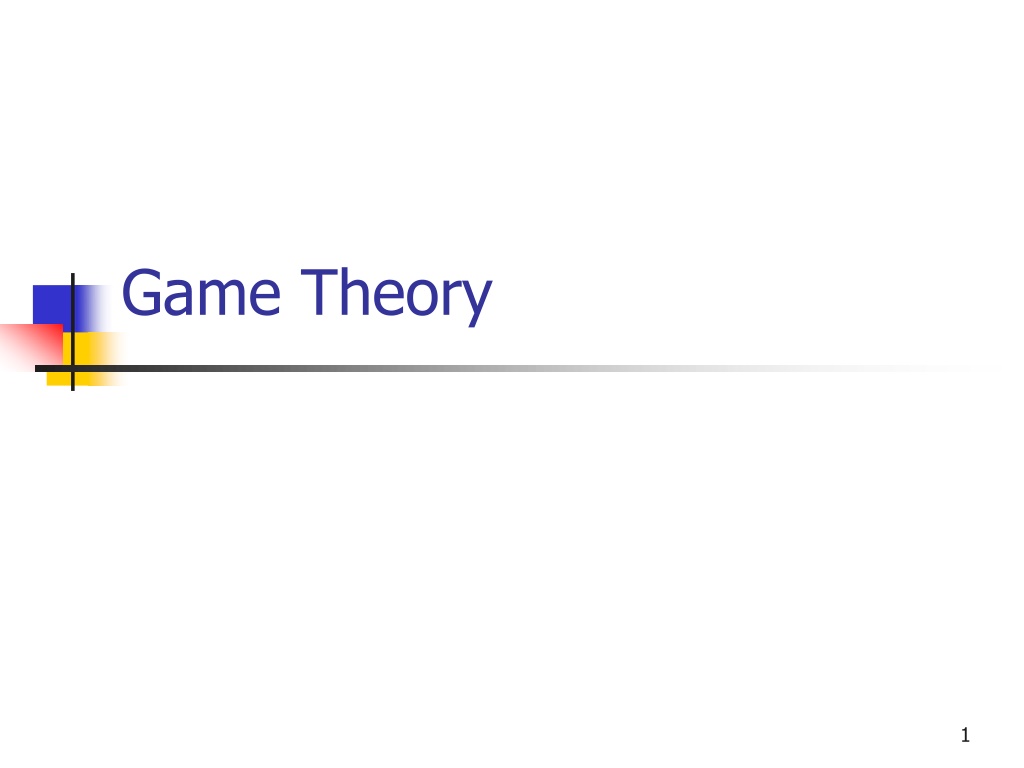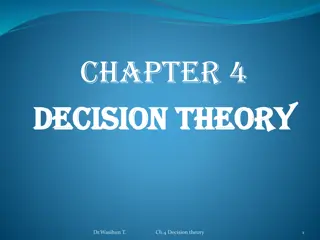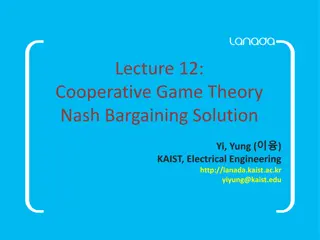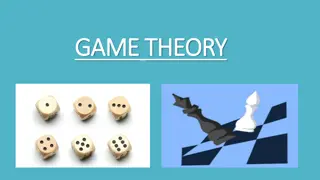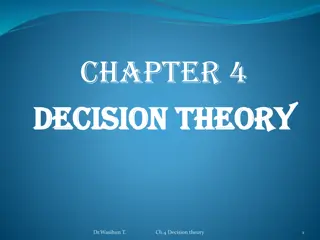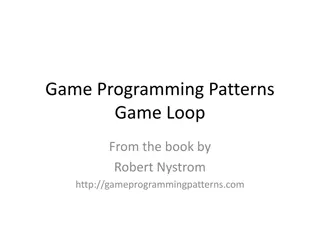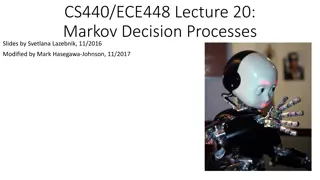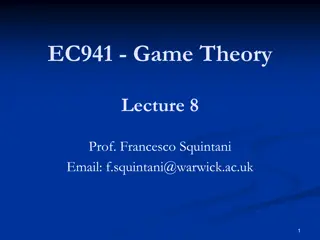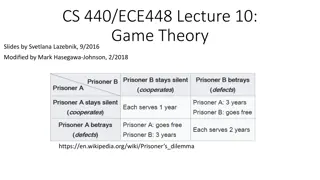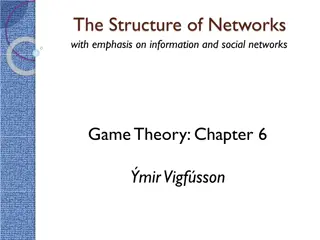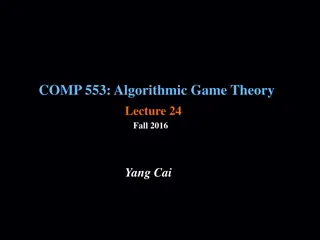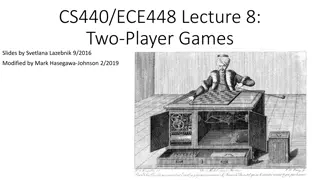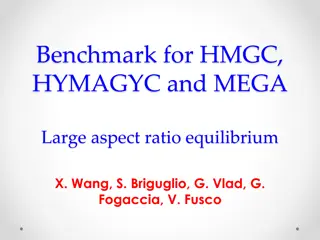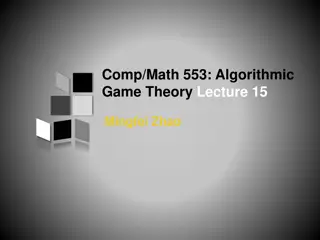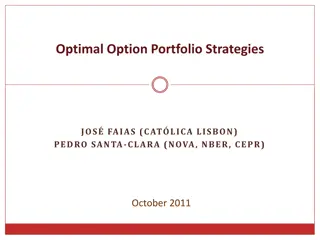Understanding Game Theory: Strategies, Payoffs, and Equilibriums
Explore the world of game theory through concepts like dominant strategies, Nash equilibrium, game trees, and matrix forms. Delve into examples involving decision-making scenarios among players to grasp the intricate dynamics of strategic interactions.
Download Presentation

Please find below an Image/Link to download the presentation.
The content on the website is provided AS IS for your information and personal use only. It may not be sold, licensed, or shared on other websites without obtaining consent from the author. Download presentation by click this link. If you encounter any issues during the download, it is possible that the publisher has removed the file from their server.
E N D
Presentation Transcript
Agenda Game Theory Matrix Form of a Game Dominant Strategy and Dominated Strategy Nash Equilibrium Game Trees Subgame Perfection 2
Game Theory Game theory is the study of a set of tools that can be used to analyze decision-making by a set of players who interact with each other through a set of strategies. 3
Matrix Form of the Game The matrix form of a game represents the strategies and payoff of those strategies in a matrix. The key components of this is the players, the strategies, and the payoffs of the strategies. The matrix form is a useful tool when the players of the game must move simultaneously. 4
Matrix Form of the Game Cont. Player 2 Strategy A Strategy B (Player 1 payoff, Player 2 payoff) (Player 1 payoff, Player 2 payoff) Strategy 1 Player 1 (Player 1 payoff, Player 2 payoff) (Player 1 payoff, Player 2 payoff) Strategy 2 5
Matrix Form Example Suppose there were two producers of hogs, Farmer A and Farmer B. Assume that there are two strategies for farmer A: be large or be small. Assume that there are two strategies for farmer B: decrease size or increase size. If farmer A chooses small and Farmer B chooses decrease, they will evenly split 100. 6
Matrix Form Example Cont. If farmer A chooses large and Farmer B chooses increase, they will evenly split 80. If farmer A chooses large and Farmer B chooses decrease, then farmer A gets 60 and farmer B gets 20. If farmer A chooses small and Farmer B chooses increase, then farmer A gets 30 and farmer B gets 70. 7
Matrix Form Example Cont. Players: Farmer A, Farmer B Strategies: Large, Small, Increase, Decrease Payoffs: Large, increase implies (40, 40) Large, decrease implies (60, 20) Small, decrease implies (50, 50) Small, increase implies (30, 70) 8
Matrix Form Example Farmer B Decrease Increase (50, 50) (30, 70) Small Farmer A (60, 20) (40, 40) Large 9
Dominant and Dominated Strategies Dominant Strategy Given a set of strategies, a dominant strategy is one that is better than all other strategies in that set. Dominated Strategy Given a set of strategies, a dominated strategy is one that is worse than some other strategy in that set. 10
A strategy dominates another strategy when every payoff in the dominating strategy is larger than its corresponding payoff in the strategy that is being dominated. 11
Example to Help with Terminology Farmer B Decrease Increase (PSDA, PSDB) (PSIA, PSIB) Small Farmer A (PLDA, PLDB) (PLIA, PLIB) Large 12
Example to Help with Terminology Cont. Define: PSDA as the payoff to player A if she plays strategy small and player B plays strategy decrease. PSDB as the payoff to player B if he plays strategy decrease and player A plays strategy small. PSIA as the payoff to player A if she plays strategy small and player B plays strategy increase. PSIB as the payoff to player B if he plays strategy increase and player A plays strategy small. 13
Example to Help with Terminology Cont. PLDA as the payoff to player A if she plays strategy large and player B plays strategy decrease. PLDB as the payoff to player B if he plays strategy decrease and player A plays strategy large. PLIA as the payoff to player A if she plays strategy large and player B plays strategy increase. LSIB as the payoff to player B if he plays strategy increase and player A plays strategy large. 14
Example to Help with Terminology Cont. For Player A, the small strategy dominates the large strategy if PSDA>PLDA and PSIA>PLIA . Hence, large is said to be a dominated strategy. Is small a dominant strategy? What conditions would need to hold for decrease to be a dominated strategy? 15
Nash Equilibrium A Nash Equilibrium is said to occur when given the strategies of the other players are held constant, there is no incentive for a player to change his strategy to get a higher payoff. In essence, a Nash Equilibrium occurs when all players in the game do not want to change their strategies given the other players strategies. 16
Nash Equilibrium Cont. A Nash Equilibrium will be in a Dominant Strategy. A Nash Equilibrium will never be in a dominated strategy. 17
Matrix Form Example with Nash Equilibrium Farmer B Decrease Increase (50, 50) (30, 70) Small Farmer A (60, 20) (40, 40) Nash Equilibrium Large 18
Prisoners Dilemma A Prisoners Dilemma occurs when all parties through noncooperative strategies obtain a less than optimal solution due to their self interest. In the previous example, the Nash Equilibrium occurred at a sub-optimal solution for the game where farmer A chose large and Farmer B chose increase. They both would have been better off by choosing small, decrease. 19
Game Trees A Game Tree is a way of representing a sequential move game. It is also known as the extensive form of a game. There are four components to a Game Tree. Players Payoffs Nodes A node represents a position within the game. Actions An action is a move that moves from one node to the next. 20
Representation of Game Tree Player 2 Player 1 Payoff, Player 2 Payoff Action 3 Player 1 Action 4 Player 1 Payoff, Player 2 Payoff Action 1 Player 1 Payoff, Player 2 Payoff Action 5 Action 2 Action 6 Player 1 Payoff, Player 2 Payoff 21
Game Tree Representation Using Previous Example Assuming Farmer A Moves First Farmer B 50, 50 Decrease Farmer A Increase 30, 70 Small 60, 20 Decrease Large Increase 40, 40 22
Subgame Perfection When working with a Game Tree, an important equilibrium concept is the Subgame Perfect Nash Equilibrium (SPNE). A SPNE is said to exist if each player chooses an optimal action at each stage in the game that it might conceivably reach and believes that all other players will behave in the same way. (Besanko) 23
Subgame Perfection Cont. SPNE can be found by using a method called the rollback method. In the rollback method, you start at the end of the tree and work your way back to find the best strategies for each node. For our purposes, we can also call this a rollback equilibrium. 24
Subgame Perfection Example 2 Farmer B Exit 50, 50 65, 55 Decrease 100, 60 SPNE Increase Farmer A 55, 65 Large Exit 90, 90 Medium Decrease 120, 70 Increase 60, 100 Small Exit 70, 120 Decrease 110, 110 Increase 25
Subgame Perfection Example 2 The SPNE is where Farmer A becomes large and Farmer B increases. This gives a payoff of 100 to Farmer A and a payoff of 60 to Farmer B. If this was a simultaneous move game, what would the outcome had been? 26
